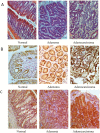A novel mouse model of sporadic colon cancer induced by combination of conditional Apc genes and chemical carcinogen in the absence of Cre recombinase
- PMID: 30859181
- PMCID: PMC6875902
- DOI: 10.1093/carcin/bgz050
A novel mouse model of sporadic colon cancer induced by combination of conditional Apc genes and chemical carcinogen in the absence of Cre recombinase
Abstract
Although valuable insights into colon cancer biology have been garnered from human colon cancer cell lines and primary colonic tissues, and animal studies using human colon cancer xenografts, immunocompetent mouse models of spontaneous or chemically induced colon cancer better phenocopy human disease. As most sporadic human colon tumors present adenomatous polyposis coli (APC) gene mutations, considerable effort has gone into developing mice that express mutant Apc alleles that mimic human colon cancer pathogenesis. A serious limitation of many of these Apc-mutant murine models, however, is that these mice develop numerous tumors in the small intestine but few, if any, in the colon. In this work, we examined three spontaneous mouse models of colon tumorigenesis based upon the widely used multiple intestinal neoplasia (Min) mouse: mice with either constitutive or conditional Apc mutations alone or in combination with caudal-related homeobox transcription factor CDX2P-Cre transgene - either with or without exposure to the potent colon carcinogen azoxymethane. Using the CDX2 promoter to drive Cre recombinase transgene expression effectively inactivated Apc in colonocytes, creating a model with earlier tumor onset and increased tumor incidence/burden, but without the Min mouse model's small intestine tumorigenesis and susceptibility to intestinal perforation/ulceration/hemorrhage. Most significantly, azoxymethane-treated mice with conditional Apc expression, but absent the Cre recombinase gene, demonstrated nearly 50% tumor incidence with two or more large colon tumors per mouse of human-like histology, but no small intestine tumors - unlike the azoxymethane-resistant C57BL/6J-background Min mouse model. As such this model provides a robust platform for chemoprevention studies.
© The Author(s) 2019. Published by Oxford University Press. All rights reserved. For Permissions, please email: journals.permissions@oup.com.
Figures





Similar articles
-
Enhanced colon carcinogenesis induced by azoxymethane in min mice occurs via a mechanism independent of beta-catenin mutation.Cancer Lett. 2002 Sep 8;183(1):31-41. doi: 10.1016/s0304-3835(02)00114-3. Cancer Lett. 2002. PMID: 12049812
-
Mouse model of colonic adenoma-carcinoma progression based on somatic Apc inactivation.Cancer Res. 2007 Oct 15;67(20):9721-30. doi: 10.1158/0008-5472.CAN-07-2735. Cancer Res. 2007. PMID: 17942902
-
Colon-specific tumorigenesis in mice driven by Cre-mediated inactivation of Apc and activation of mutant Kras.Cancer Lett. 2014 Jun 1;347(2):191-5. doi: 10.1016/j.canlet.2014.03.004. Epub 2014 Mar 14. Cancer Lett. 2014. PMID: 24632531 Free PMC article.
-
Chemoprevention of colon cancer by Korean food plant components.Mutat Res. 2003 Feb-Mar;523-524:99-107. doi: 10.1016/s0027-5107(02)00325-1. Mutat Res. 2003. PMID: 12628507 Review.
-
Multistep carcinogenesis of the colon in Apc(Min/+) mouse.Cancer Sci. 2007 Jan;98(1):6-10. doi: 10.1111/j.1349-7006.2006.00348.x. Cancer Sci. 2007. PMID: 17052257 Free PMC article. Review.
Cited by
-
The role of farnesoid X receptor in metabolic diseases, and gastrointestinal and liver cancer.Nat Rev Gastroenterol Hepatol. 2021 May;18(5):335-347. doi: 10.1038/s41575-020-00404-2. Epub 2021 Feb 10. Nat Rev Gastroenterol Hepatol. 2021. PMID: 33568795 Review.
-
Model systems to study tumor-microbiome interactions in early-onset colorectal cancer.EMBO Mol Med. 2025 Mar;17(3):395-413. doi: 10.1038/s44321-025-00198-3. Epub 2025 Feb 13. EMBO Mol Med. 2025. PMID: 39948421 Free PMC article. Review.
-
Mouse Models for Application in Colorectal Cancer: Understanding the Pathogenesis and Relevance to the Human Condition.Biomedicines. 2022 Jul 15;10(7):1710. doi: 10.3390/biomedicines10071710. Biomedicines. 2022. PMID: 35885015 Free PMC article. Review.
-
Complement downregulation promotes an inflammatory signature that renders colorectal cancer susceptible to immunotherapy.J Immunother Cancer. 2022 Sep;10(9):e004717. doi: 10.1136/jitc-2022-004717. J Immunother Cancer. 2022. PMID: 36137652 Free PMC article.
-
Increased Incidence of Colon Tumors in AOM-Treated Apc 1638N/+ Mice Reveals Higher Frequency of Tumor Associated Neutrophils in Colon Than Small Intestine.Front Oncol. 2019 Oct 2;9:1001. doi: 10.3389/fonc.2019.01001. eCollection 2019. Front Oncol. 2019. PMID: 31681563 Free PMC article.
References
-
- American Cancer Society. (2017) Colorectal Cancer Facts & Figures 2017–2019. American Cancer Society, Atlanta, GA.
-
- Siegel R.L., et al. (2017) Colorectal cancer statistics, 2017. CA. Cancer J. Clin., 67, 177–193. - PubMed
-
- Fodde R., et al. (2001) APC, signal transduction and genetic instability in colorectal cancer. Nat. Rev. Cancer, 1, 55–67. - PubMed
Publication types
MeSH terms
Substances
Grants and funding
LinkOut - more resources
Full Text Sources
Molecular Biology Databases
Research Materials

